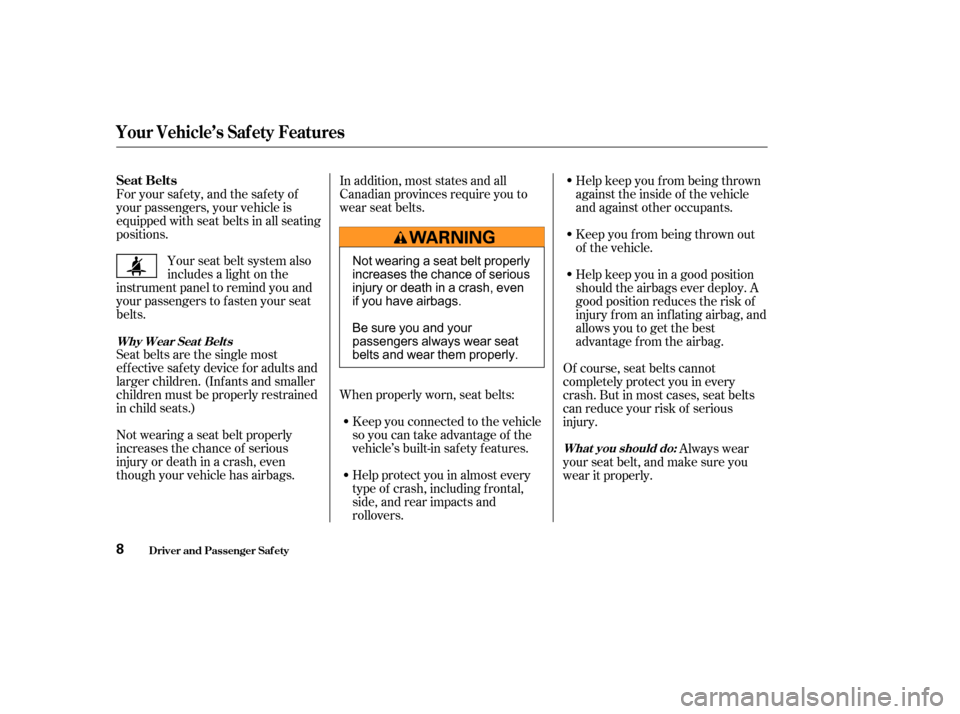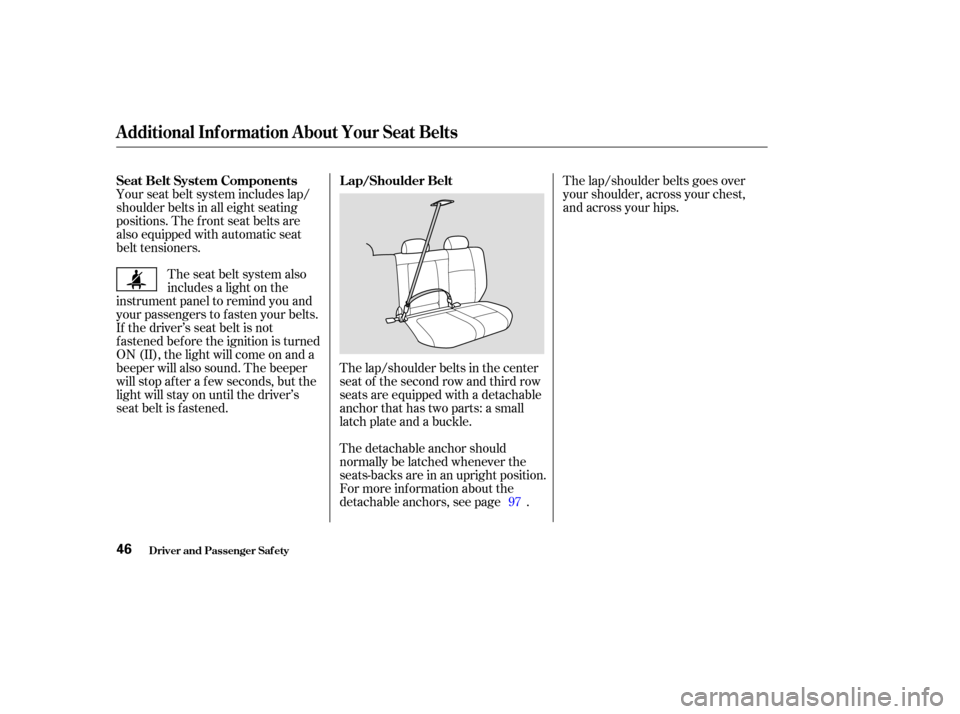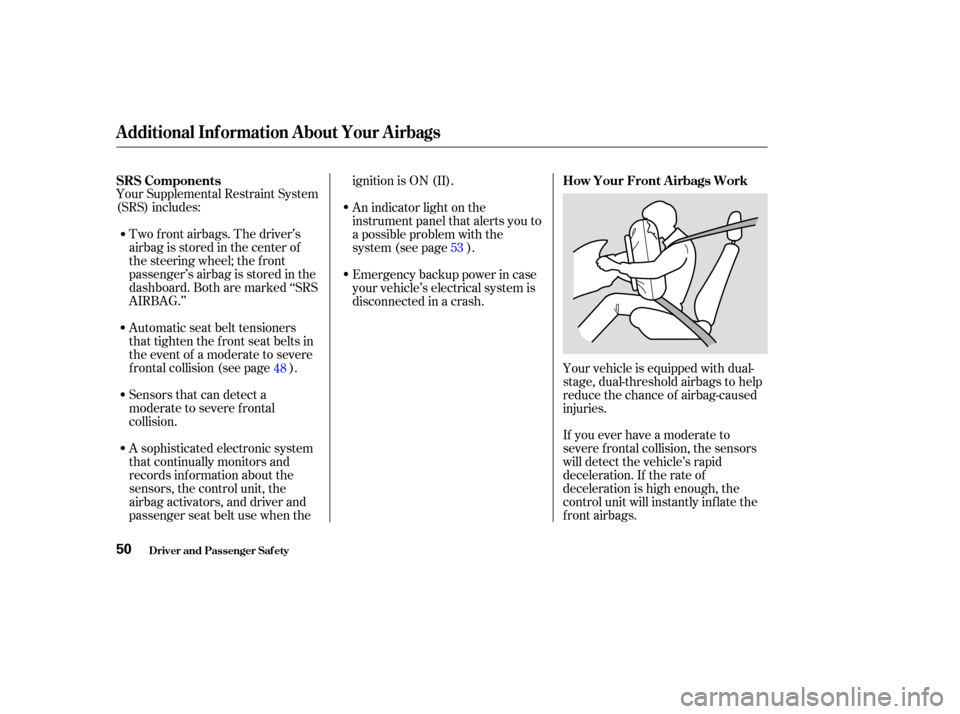Page 6 of 392
Your Vehicle at a Glance
2
INDICATOR LIGHTSGAUGES
POWER DOOR LOCK
SWITCHES
MIRROR
CONTROLS
POWER WINDOW
SWITCHES
HOOD RELEASE
HANDLE AUDIO SYSTEM
CLIMATE CONTROL
SYSTEM
(P.61)
(P.67)
(P.82)
(P.103)
(P.99)
(P.218) (P.110)(P.118,
128)
(P.137,
153,168)
FUEL FILL DOOR
RELEASE (P.217) PARKING BRAKE
PEDAL
(P.104)
REAR A/C CONTROL
(P.135) ACCESSORY POWER SOCKETS
Page 7 of 392
�Î
�Î
To use the horn, press the pad around the ‘‘H’’ logo.
:
Your Vehicle at a Glance
3
HEADLIGHTS/TURN SIGNALS
LIGHT CONTROL
SWITCH
CRUISE
CONTROL
REMOTE AUDIO
CONTROLS STEERING WHEEL
ADJUSTMENT CRUISE CONTROL
WINDSHIELD WIPERS/
WASHERS
(P.112)
(P.72/
74)
(P.207) (P.188) (P.78) (P.74/
76)
HORN
HAZARD WARNING
LIGHTS
REAR WINDOW
DEFOGGER
(P.77)
(P.
238 )
(P.77)
(P.207) VTM-4
LOCK
Page 9 of 392

This section gives you important
inf ormation about how to protect
yourself and your passengers. It
shows you how to use seat belts
properly. It explains your Supple-
mental Restraint System. And it tells
you how to properly restrain inf ants
and children in your vehicle..........
Important Safety Precautions . 6
.......
Your Vehicle’s Saf ety Features . 7
.......................................
Seat Belts .8
...........................................
Airbags .9
.....................
Seats & Seat-Backs .10
..........................
Head Restraints .10
..................................
Door Locks .10
........
Pre-Drive Saf ety Checklist . 11
............................
Protecting Adults .12 .....
1. Close and Lock the Doors . 12
...........
2. Adjust the Front Seats . 12
............
3. Adjust the Seat-Backs . 13
...
4. Adjust the Head Restraints . 14
5. Fasten and Position the Seat .....................................
Belts .15
....
6. Adjust the Steering Wheel . 18
7. Maintain a Proper Sitting ................................
Position .18
.....
Advice f or Pregnant Women . 19
...
Additional Safety Precautions . 19
........................
Protecting Children .21
All Children Must Be ...............................
Restrained .21
Children Should Sit in the Back ...........................................
Seat .22
The Passenger’s Airbag Poses ......
Serious Risks to Children . 23
If You Must Drive with Several ...................................
Children .25
If a Child Requires Close ..................................
Attention .25
...
Additional Safety Precautions . 25
General Guidelines f or Using ...............................
Child Seats .26
.......................
Protecting Inf ants .30 .........
Protecting Small Children . 35
.......
Protecting Larger Children . 38
Using Child Seats with .....................................
Tethers .42
.............................
Using LATCH .44
Additional Inf ormation About Your .................................
Seat Belts .46
..
Seat Belt System Components . 46
......................
Lap/Shoulder Belt .46
Automatic Seat Belt ...............................
Tensioners .48
...............
Seat Belt Maintenance . 49
Additional Inf ormation About Your .....................................
Airbags .50
........................
SRS Components .50
How Your Front Airbags .........................................
Work .50
...
How Your Side Airbags Work . 52
How the SRS Indicator Light .......................................
Works .53
How The Side Airbag Cutof f ...........
Indicator Light Works . 54
.............................
Airbag Service .55
...
Additional Safety Precautions . 55
.............
Carbon Monoxide Hazard . 56
...................................
Saf ety Labels .57
Driver and Passenger Saf ety
Driver and Passenger Saf ety5
Page 12 of 392

Your seat belt system also
includes a light on the
instrument panel to remind you and
your passengers to f asten your seat
belts.
Seat belts are the single most
effectivesafetydeviceforadultsand
larger children. (Inf ants and smaller
children must be properly restrained
in child seats.)
Not wearing a seat belt properly
increases the chance of serious
injury or death in a crash, even
though your vehicle has airbags. Foryoursafety,andthesafetyof
your passengers, your vehicle is
equipped with seat belts in all seating
positions. In addition, most states and all
Canadian provinces require you to
wear seat belts.
Help protect you in almost every
type of crash, including f rontal,
side, and rear impacts and
rollovers. Keep you connected to the vehicle
so you can take advantage of the
vehicle’s built-in saf ety f eatures.
When properly worn, seat belts: Help keep you f rom being thrown
against the inside of the vehicle
and against other occupants.
Keep you f rom being thrown out
of the vehicle.
Help keep you in a good position
should the airbags ever deploy. A
good position reduces the risk of
injury f rom an inf lating airbag, and
allows you to get the best
advantage f rom the airbag.
Of course, seat belts cannot
completely protect you in every
crash.Butinmostcases,seatbelts
can reduce your risk of serious
injury. Always wear
your seat belt, and make sure you
wear it properly.
Driver and Passenger Saf ety
Seat Belts
Why Wear Seat Belt s
What you should do:
Your Vehicle’s Saf ety Features
8
Not wearing a seat belt properly
increases the chance of serious
injury or death in a crash, even
if you have airbags.
Be sure you and your
passengers always wear seat
belts and wear them properly.
Page 16 of 392

The f ollowing pages provide
instructions on how to properly
protect the driver and other adult
occupants.
These instructions also apply to
children who have outgrown child
seats and are large enough to wear
lap/shoulder belts. (See page f or
important additional guidelines on
how to properly protect larger
children.)Your vehicle has a door and tailgate
monitor light on the instrument
panel to indicate when a specif ic
door or the tailgate is not tightly
closed.
For security, locked doors can
prevent an outsider f rom
unexpectedly opening a door when
you come to a stop.
See page f or how to lock the
doors. For saf ety, locking the doors reduces
the chance that a passenger,
especially a child, will open a door
while the vehicle is moving and
accidentally f all out. It also reduces
the chance of someone being thrown
out of the vehicle during a crash.
Af ter everyone has entered the
vehicle, be sure the doors and
tailgate are closed and locked. Any driver who sits too close to the
steering wheel is at risk of being
seriously injured or killed by striking
the steering wheel or f rom being
struck by an inflating front airbag
during a crash.
38
82
Driver and Passenger Saf ety
Protecting Adults
Introduction A djust the Front Seats
Close and L ock the Doors
1. 2.
12
Page 50 of 392

The seat belt system also
includes a light on the
instrument panel to remind you and
your passengers to f asten your belts.
If the driver’s seat belt is not
fastened before the ignition is turned
ON (II), the light will come on and a
beeper will also sound. The beeper
will stop af ter a f ew seconds, but the
light will stay on until the driver’s
seat belt is f astened. The lap/shoulder belts goes over
your shoulder, across your chest,
and across your hips.
Your seat belt system includes lap/
shoulder belts in all eight seating
positions. The f ront seat belts are
also equipped with automatic seat
belt tensioners.
The lap/shoulder belts in the center
seat of the second row and third row
seats are equipped with a detachable
anchor that has two parts: a small
latch plate and a buckle.
The detachable anchor should
normally be latched whenever the
seats-backs are in an upright position.
For more inf ormation about the
detachable anchors, see page .97
Seat Belt System Components L ap/Shoulder Belt
Additional Inf ormation About Your Seat Belts
Driver and Passenger Saf ety46
Page 52 of 392
If your airbags inf late, the tensioners
immediately tighten the f ront seat
belts to help hold the occupants in
place. The belts will remain tight
until you unbuckle them in the
normal way.The SRS indicator light will
come on if there is a
problem with your automatic seat
belt tensioners (see page ).
Your vehicle has automatic seat belt
tensioners f or added protection
during a moderate to severe frontal
collision. 53
A utomatic Seat Belt T ensioners
Driver and Passenger Saf ety
Additional Inf ormation About Your Seat Belts
48
Page 54 of 392

Your Supplemental Restraint System
(SRS) includes:Two f ront airbags. The driver’s
airbag is stored in the center of
the steering wheel; the f ront
passenger’sairbagisstoredinthe
dashboard. Both are marked ‘‘SRS
AIRBAG.’’
Automatic seat belt tensioners
that tighten the front seat belts in
the event of a moderate to severe
f rontal collision (see page ).
Sensors that can detect a
moderate to severe frontal
collision.
A sophisticated electronic system
that continually monitors and
records inf ormation about the
sensors, the control unit, the
airbag activators, and driver and
passenger seat belt use when the ignition is ON (II).
An indicator light on the
instrument panel that alerts you to
a possible problem with the
system (see page ).
Emergency backup power in case
your vehicle’s electrical system is
disconnected in a crash.
If you ever have a moderate to
severe f rontal collision, the sensors
will detect the vehicle’s rapid
deceleration. If the rate of
deceleration is high enough, the
control unit will instantly inf late the
f ront airbags. Your vehicle is equipped with dual-
stage, dual-threshold airbags to help
reduce the chance of airbag-caused
injuries.
48 53
SRS Components
How Your Front A irbags Work
Driver and Passenger Saf ety
Additional Inf ormation About Your Airbags
50